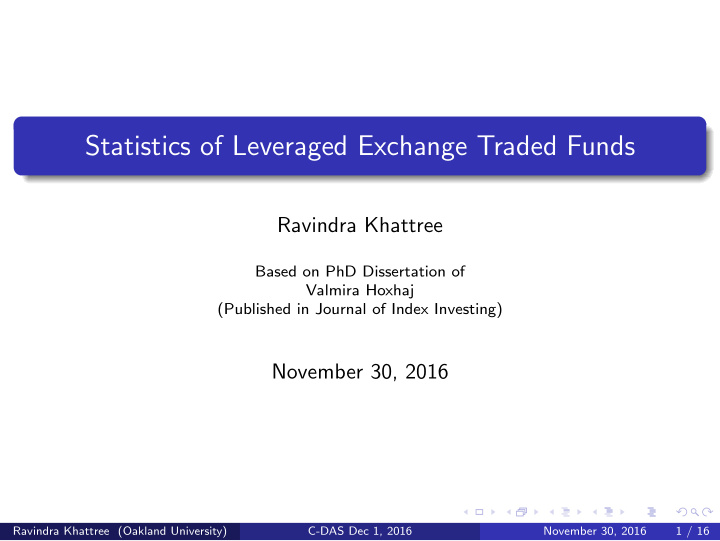



Statistics of Leveraged Exchange Traded Funds Ravindra Khattree Based on PhD Dissertation of Valmira Hoxhaj (Published in Journal of Index Investing) November 30, 2016 Ravindra Khattree (Oakland University) C-DAS Dec 1, 2016 November 30, 2016 1 / 16
Investment Investment is an aspect of Data Science dealing with trading activities 1 Data used in technical analysis: charts and patterns... Data used in the form of Company’s financial health and other related information Qualitative data, such as political news (elections, Clinton’s e-mail episode), world events (Brexit), catastrophic events (Fukushima), Social activities (Facebook).... Basic issue is prediction of the behavior of the market. Perhaps one of the most challenging modeling problem with large noisy data. Ravindra Khattree (Oakland University) C-DAS Dec 1, 2016 November 30, 2016 2 / 16
Simplest Investments Stocks: Very much affected by various factors; Can be traded any time during trading hours or even after hours; They can be very volatile. Mutual Funds: Baskets of stocks; Effects of various factors is lessened due to averaging; Can be bought and sold only once a day at the end of the day; Hence less volatile than individual stocks. Ravindra Khattree (Oakland University) C-DAS Dec 1, 2016 November 30, 2016 3 / 16
Simplest Investments Exchange Traded Funds (ETF): Similar to mutual funds; Baskets of stocks; Effects of various factors is lessened due to averaging; Can be bought and sold any time during trading hours or even after hours; Less volatile than stocks; Supposedly more tax efficient than mutual funds; Usually align themselves with some market index. Ravindra Khattree (Oakland University) C-DAS Dec 1, 2016 November 30, 2016 4 / 16
Leveraged ETF Leveraged Exchange Traded Funds: Attempt to enhance the return of an index (such as NASDAQ or S & P 500) by a factor (2 × or 3 × ); Invest borrowed money to do so; 2 × : When index goes up (down) by 1%, fund goes up (down) by 2% 3 × : When index goes up (down) by 1%, fund goes up (down) by 3% − 1 × : When index goes up (down) by 1%, fund goes down (up) by 1% − 2 × : When index goes up (down) by 1%, fund goes down (up) by 2% − 3 × : When index goes up (down) by 1%, fund goes down (up) by 3% Last three choices correspond to inverse leveraged funds , and can be an alternative to shorting . Ravindra Khattree (Oakland University) C-DAS Dec 1, 2016 November 30, 2016 5 / 16
Leveraged ETF Clearly, Leveraged ETFs are more volatile than index. Enhanced returns by a specified factor on a daily basis only . Due to rebalancing of assets on daily basis, use of borrowed money, and effect of compounding, a 2 × fund may not have two times return in long term. In fact, in an static market going nowhere, one is bound to lose money in long run if invested in an leveraged fund. Ravindra Khattree (Oakland University) C-DAS Dec 1, 2016 November 30, 2016 6 / 16
Our Work Designing of a leveraged exchange traded fund which essentially gives the same average return as a fund with specified leverage but has less variability (of the distribution of returns)and is less volatile (that is, less day-to-day variability of returns). Ravindra Khattree (Oakland University) C-DAS Dec 1, 2016 November 30, 2016 7 / 16
Our Work The basic idea is: Replace the daily rebalancing requirement by having a rule that when the market is up, sell c % of assets under management and when the market is down buy additional c % of assets under management. ( c must be chosen carefully) Let the leverage factor (2 × or 3 × ) be random rather than fixed. In fact, even when leverage factor was targeted to be kept fixed at 2 × or 3 × , we can never keep it fixed. Daily returns are assumed to have a probability distribution. This reduces the standard deviation of the distribution of returns as well as day-to-day volatility, yet keeps the leverage factor, on an average, same. Long term performance remains same. Ravindra Khattree (Oakland University) C-DAS Dec 1, 2016 November 30, 2016 8 / 16
Simulations Validation of the Work is based on extensive simulations. Randomness of market returns and randomness of leverage factors result in a time series of returns of leverage funds. Performance is shown in the tables and pictures that follow. Ravindra Khattree (Oakland University) C-DAS Dec 1, 2016 November 30, 2016 9 / 16
Mean Compounded Returns Ravindra Khattree (Oakland University) C-DAS Dec 1, 2016 November 30, 2016 10 / 16
Standard Deviation of Compounded Returns Ravindra Khattree (Oakland University) C-DAS Dec 1, 2016 November 30, 2016 11 / 16
Mean Compounded Returns: Longer Term Ravindra Khattree (Oakland University) C-DAS Dec 1, 2016 November 30, 2016 12 / 16
Standard Deviation of Compounded Returns: Longer Term Ravindra Khattree (Oakland University) C-DAS Dec 1, 2016 November 30, 2016 13 / 16
Mean Compounded Returns Ravindra Khattree (Oakland University) C-DAS Dec 1, 2016 November 30, 2016 14 / 16
Standard Deviation of Compounded Returns Ravindra Khattree (Oakland University) C-DAS Dec 1, 2016 November 30, 2016 15 / 16
Mean Volatility Ravindra Khattree (Oakland University) C-DAS Dec 1, 2016 November 30, 2016 16 / 16
Recommend
More recommend